|
Snohomish County Surface Water Management collaborate with residents of Lake Goodwin and Shoecraft to control invasive Eurasian watermilfoil. This is an update of the 2020 efforts that are paid for, in part, by lake residents through an aquatic plant fee. See the project website for more details and a complete history. |
|
|
2020 Milfoil Control Update
This year's invasive Eurasian watermilfoil control efforts wrapped up in mid-August. Work included ten days of diver surveying and milfoil removal by Seascapes Aquatic Services. We are happy to report that the milfoil levels are at their lowest since control work began in the mid 1990's! Last year's Procellacor herbicide treatment was highly effective as follows:
|
|
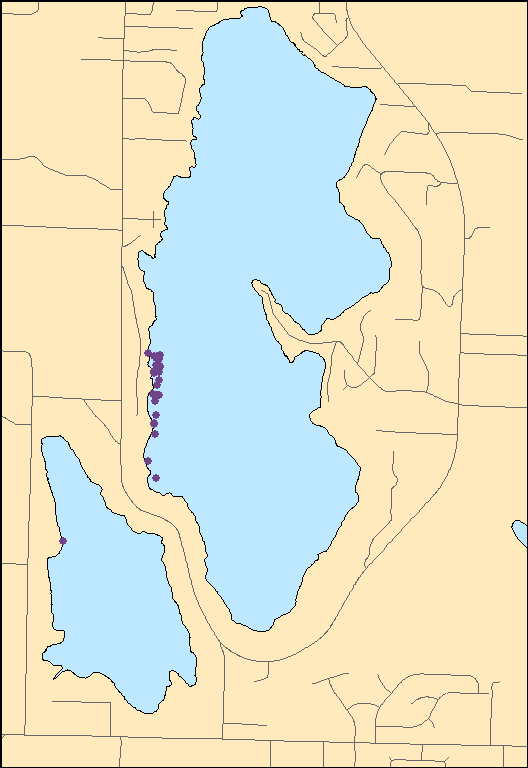 2020 Eurasian Watermilfoil locations (dots represent 1-3 plants)
|
|
Lake Goodwin
In seven days, divers surveyed the entire shoreline. Areas with historic milfoil hot spots were surveyed twice. Only 30-40 milfoil plants were found as shown in the map. All plants were hand-pulled or removed using Seascape's diver suction harvesting technology.
Lake Shoecraft
In 3 days of diving, the entire shoreline was surveyed twice including an intense survey of the northern cove. Only one milfoil plant was found and removed. A big thanks goes out to the resident who allowed us to use their private launch to complete this year's work!
See more information on our project website.
|
|
|
Milfoil Versus Native Aquatic Plants
Many lake residents were concerned that plants near their dock may be milfoil. However, since very little milfoil was found this year, you are likely seeing beneficial native plants. In fact, these two lakes have over 20 native plant species! Native plants provide many benefits to the lake such as:
- Better fishing – fish eat the critters that grow in plants and provide places for young fish to hide.
- Beneficial habitat – turtles, frogs, ducks, and songbirds, are just a few of the animals that rely on aquatic plants for food or homes.
- Erosion Control - Aquatic plants protect shorelines from waves and erosion. They also help keep sediment on the lake bottom keeping the water clearer.
- Cleaner Water – Aquatic plants can soak up pollutants from contaminated water and prevent larger amounts of algae growth.
Native plants should be left in place because of their strong benefits to the lake. However, if densely growing native plants are preventing you from swimming or using your boat, there are some options to remove small areas, if guidelines set forth by the Department of Fish and Wildlife are followed. More information can be found on our aquatic plant web page.
Eurasian watermilfoil is different. It is a non-native plants that does not provide the same habitat and food benefits to most native aquatic life. It is particularly problematic as it grows aggressively and has few to no natural controls. It can take over a lake system displacing native plants and the animals that rely on as well as greatly impairing boating, swimming and fishing.
How Do I Tell - Invasive Milfoil or Beneficial Native Plant?
Below are a few of the most common beneficial native plants in Goodwin and Shoecraft followed by pictures of Eurasian watermilfoil. You can see more plants and tips for identification on our aquatic plant web page.
|
|
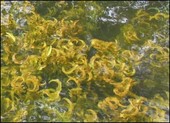 Large leaf pondweed - this native plant has large, curling leaves underwater and small, oval leaves floating on the surface.
|
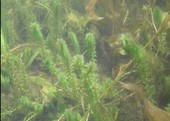 Elodea - this native plant has spiky leaves in whorls of 3 around the stem.
|
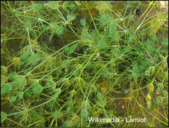 Chara - this native is actually an algae. It grows near the lake bottom and smells a bit like garlic.
|
|
|
Milfoil can be identified by it's small feathery leaves
|
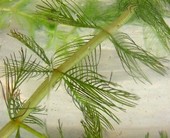 Milfoil pieces as small as one inch can break off and grow a new plant
|
 Dense milfoil can make swimming and boating difficult
|
|
|
What You Can Do to Help Prevent the Spread of Invasive Plants:
- Check your boats and fishing gear when you enter or leave any lake; remove all plant fragments and toss them in the trash
- Learn how to identify milfoil and more about other aquatic plants at www.lakes.surfacewater.info
|
|
|
|